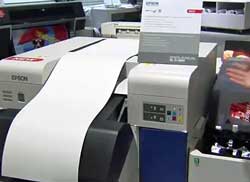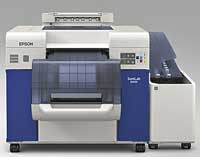![]() Fresh from the massive European printing industry trade exhibition, DRUPA (May 3 – 16), Epson is bringing its long-awaited entry into the dry minilab market, the Epson Surelab SL-3000, to The Digital Show next week.
Fresh from the massive European printing industry trade exhibition, DRUPA (May 3 – 16), Epson is bringing its long-awaited entry into the dry minilab market, the Epson Surelab SL-3000, to The Digital Show next week.

The new 6-colour Epson SureLab SL-D3000 is an easy-to-use digital dry lab for high quality photo prints and cards up to A3 size. It features Epson printheads, new Epson UltraChrome D6 dye ink and image processing technology, and is designed for on-demand print services in traditional minilab retail environments.
It can print on glossy, matte and lustre media, at up to 650 prints per hour. Maximum print length is 1.2m. Compatibility with matte media opens up greater opportunities for retailers to take on signage work in addition to consumer photo orders.
Epson technology has been used in Noritsu’s well-proven dry lab range for the last few years, but this is the company’s direct entry with a branded product and all in-house technology. It follows the announcement in March of the Dreamlabo 5000 from Canon, a much larger ($500,000+) wholesale fulfillment/pro lab duplex inkjet printer.
Now the ‘Big 3’ in photo-quality inkjet printing, Canon, Epson and HP, are all offering products for retail photo printing, with the new Epson printer a direct alternative to some of HP’s in-store inkjet printing technology.
More broadly, the announcement of the Surelab SL 3000 is a component of a new Epson direction, which focusses sharply on technologies for production and industrial print applications.
The new Epson ‘Engineered for Print’ strategy flags an intention to develop and market products and technologies for customers in the signage, label, photo, and textile markets, with goals of doubling its product line-up in the next few years and quadrupling revenue from industrial printing.
The SL-D3000 utilizes Epson’s Micro Piezo printhead technology, in combination with Epson’s original ink and LUT (Look Up Table), to deliver accurate reproduction and a maximum resolution of 1440x1440dpi. Epson’s UltraChrome D6 6-colour photo ink-set achieves a colour gamut that exceeds that of silver halide, yielding prints that Epson says are ‘vivid and lifelike with excellent black density’.
Minimal maintenance, energy efficient
The power-efficient SL-D3000 uses significantly less energy than a wet lab, and does not need a water supply, air filter or chemicals, reducing impact on the environment and the total cost of ownership. Further lowering the cost per print, the printhead and LUT are carefully configured to use ink economically while maintaining the best print quality.
The SL-D3000. does not require highly-skilled operators. The optional ‘OrderController’ software, which includes basic photo retouching, makes setting up jobs easy. The SL-D3000 begins printing quickly without the need to warm-up chemicals, and can automatically move finished prints to an optional A4 job sorter.
Epson claims the only regular maintenance required is consumables replacement.
For placement flexibility and easy installation, the SL-D3000 has wheels and a small footprint. It can be positioned in a corner to save space, as it is operated from two adjacent sides.
 The dual-roll model allows two different media types and/or two different roll widths to be loaded simultaneously for versatility and improved productivity. A single-roll configuration will also be available.
The dual-roll model allows two different media types and/or two different roll widths to be loaded simultaneously for versatility and improved productivity. A single-roll configuration will also be available.
Specific pricing and availability details for the local market have not yet been revealed, but overseas pricing would indicate a fully configured D3000 should be well under $100,000.





Given HP have pulled the plug on its variant, and left major photo-retailers in contract limbo , this may prove a winner for Epson. K-Mart, Walmart and many other outlets will have to change sooner than later. HP is a badly managed conglomerate that trashes value where-ever it goes. But at least there are a number of dry-lab and inkjet alternatives to take the edge of the pain of dealing in this space. Agfa and HP, and I bet, Kodak, are all companies that will ultimately leave this space. Of course, Epson and Canon could accelerate their demise by cost attractive alternatives. Dye sublimation is also a good process, but frankly, it may have also had its day.